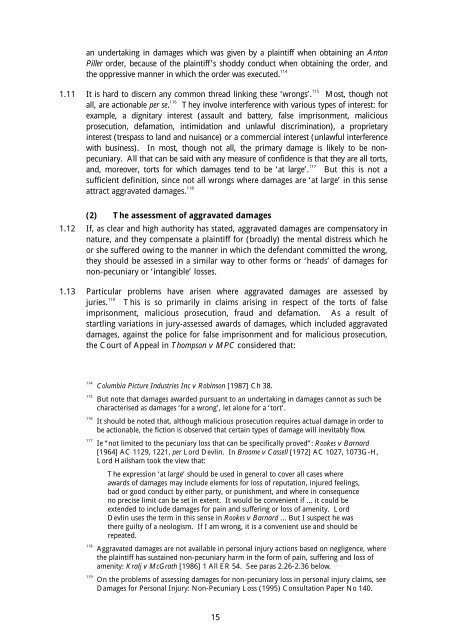Aggravated, Exemplary and Restitutionary ... - Law Commission
Aggravated, Exemplary and Restitutionary ... - Law Commission
Aggravated, Exemplary and Restitutionary ... - Law Commission
You also want an ePaper? Increase the reach of your titles
YUMPU automatically turns print PDFs into web optimized ePapers that Google loves.
an undertaking in damages which was given by a plaintiff when obtaining an Anton<br />
Piller order, because of the plaintiff’s shoddy conduct when obtaining the order, <strong>and</strong><br />
the oppressive manner in which the order was executed. 114<br />
1.11 It is hard to discern any common thread linking these ‘wrongs’. 115<br />
Most, though not<br />
all, are actionable per se. 116<br />
They involve interference with various types of interest: for<br />
example, a dignitary interest (assault <strong>and</strong> battery, false imprisonment, malicious<br />
prosecution, defamation, intimidation <strong>and</strong> unlawful discrimination), a proprietary<br />
interest (trespass to l<strong>and</strong> <strong>and</strong> nuisance) or a commercial interest (unlawful interference<br />
with business). In most, though not all, the primary damage is likely to be nonpecuniary.<br />
All that can be said with any measure of confidence is that they are all torts,<br />
<strong>and</strong>, moreover, torts for which damages tend to be ‘at large’. 117<br />
But this is not a<br />
sufficient definition, since not all wrongs where damages are ‘at large’ in this sense<br />
attract aggravated damages. 118<br />
(2) The assessment of aggravated damages<br />
1.12 If, as clear <strong>and</strong> high authority has stated, aggravated damages are compensatory in<br />
nature, <strong>and</strong> they compensate a plaintiff for (broadly) the mental distress which he<br />
or she suffered owing to the manner in which the defendant committed the wrong,<br />
they should be assessed in a similar way to other forms or ‘heads’ of damages for<br />
non-pecuniary or ‘intangible’ losses.<br />
1.13 Particular problems have arisen where aggravated damages are assessed by<br />
juries. 119<br />
This is so primarily in claims arising in respect of the torts of false<br />
imprisonment, malicious prosecution, fraud <strong>and</strong> defamation. As a result of<br />
startling variations in jury-assessed awards of damages, which included aggravated<br />
damages, against the police for false imprisonment <strong>and</strong> for malicious prosecution,<br />
the Court of Appeal in Thompson v MPC considered that:<br />
114 Columbia Picture Industries Inc v Robinson [1987] Ch 38.<br />
115 But note that damages awarded pursuant to an undertaking in damages cannot as such be<br />
characterised as damages ‘for a wrong’, let alone for a ‘tort’.<br />
116 It should be noted that, although malicious prosecution requires actual damage in order to<br />
be actionable, the fiction is observed that certain types of damage will inevitably flow.<br />
117 Ie “not limited to the pecuniary loss that can be specifically proved”: Rookes v Barnard<br />
[1964] AC 1129, 1221, per Lord Devlin. In Broome v Cassell [1972] AC 1027, 1073G-H,<br />
Lord Hailsham took the view that:<br />
The expression ‘at large’ should be used in general to cover all cases where<br />
awards of damages may include elements for loss of reputation, injured feelings,<br />
bad or good conduct by either party, or punishment, <strong>and</strong> where in consequence<br />
no precise limit can be set in extent. It would be convenient if ... it could be<br />
extended to include damages for pain <strong>and</strong> suffering or loss of amenity. Lord<br />
Devlin uses the term in this sense in Rookes v Barnard ... But I suspect he was<br />
there guilty of a neologism. If I am wrong, it is a convenient use <strong>and</strong> should be<br />
repeated.<br />
118 <strong>Aggravated</strong> damages are not available in personal injury actions based on negligence, where<br />
the plaintiff has sustained non-pecuniary harm in the form of pain, suffering <strong>and</strong> loss of<br />
amenity: Kralj v McGrath [1986] 1 All ER 54. See paras 2.26-2.36 below.<br />
119 On the problems of assessing damages for non-pecuniary loss in personal injury claims, see<br />
Damages for Personal Injury: Non-Pecuniary Loss (1995) Consultation Paper No 140.<br />
15
















